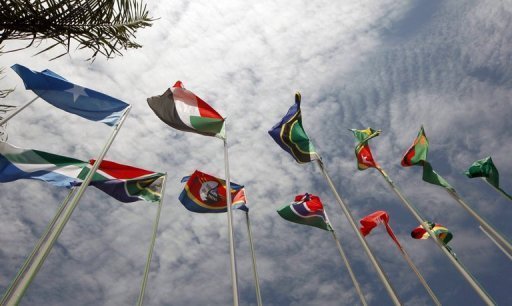
The State Council Administrative Court on Tuesday decided to refer the case that will decide the fate of the 100-member assembly writing the constitution to the Supreme Constitutional Court.
This decision might open another front between Islamists and the SCC, whose relationship is already tense after the court ordered the dissolution of the Islamist-majority People’s Assembly on 14 June. But the postponement of a final verdict might give the Islamist-dominated assembly a chance to finish drafting the constitution before the end of this year.
The following is a timeline of the troubled process to draft the first constitution after the revolution:
January-February 2012: The parliamentary elections finish with Islamists winning nearly two-thirds of the seats of both chambers, the People’s Assembly and Shura Council. The Muslim Brotherhood’s Freedom and Justice Party claim the speaker positions in both houses, as well as key committee positions.
3 March: Members of the People’s Assembly and the Shura Council meet for the first time to receive proposals for the formation of the Constituent Assembly and to determine how to make up the drafting committee. The principal dispute is whether to include MPs in the committee.
17 March: The Muslim Brotherhood tries to reach a compromise with the Salafi Nour Party, the second-largest bloc in the Parliament, who wants the assembly to contain 60 percent elected MPs. The Freedom and Justice Party proposes that 50 percent of the 100 member Constituent Assembly would be elected from Parliament, which has an Islamist majority, with the remaining half to be elected from outside Parliament. Secular forces voice opposition to having such a large ratio of MPs in the assembly.
24 March: The People's Assembly and the Shura Council put forward 100 of their members to the Constituent Assembly. The Muslim Brotherhood’s Freedom and Justice Party and the Salafi Nour Party win 36 of the 50 seats allocated to Parliament members. Islamists also make up a large number of the non-parliamentarian members of the assembly.
28 March: Leading Muslim Brotherhood figure Saad al-Katatny, who is speaker of the People's Assembly, is elected chairperson of the Constituent Assembly.
29 March: Al-Azhar withdraws from the drafting panel, delivering a blow to the assembly. Later, Al-Azhar is among another 35 members of the Constituent Assembly, including representatives of Egyptian churches and the Supreme Constitutional Court that withdraw in opposition to Islamist domination over the assembly's composition.
10 April: The Administrative Court halts the implementation of the People’s Assembly speaker’s decision to form the Constituent Assembly, saying the election of MPs to the Constituent Assembly violates Article 60 of the Constitutional Declaration.
18 April: Katatny tasks the People's Assembly’s Constitutional Affairs Committee with setting new criteria for the election of a second Constituent Assembly.
28 April: Egypt's then-ruling Supreme Council of the Armed Forces agrees with different political parties to set “six main criteria,” according to which a new constitution-drafting body will be formed. Among the criteria is the requirement of a consensus on the proportions allotted to each social and political group, and also consensus over each constitutional article.
29 April: Mahmoud al-Khodairy, head of the Legislative and Constitutional Committee of the People’s Assembly, slams the agreement between the SCAF and the political parties, saying that it undermines the Parliament’s authority to form the assembly.
23-24 May: The first free Presidential elections after the fall of Mubarak take place.
7 June: Parties agree to a new composition for the Constituent Assembly, in which parties with parliamentary representation make up 39 percent of the body.
13 June: The People's Assembly and the Shura Council approve the new formation of the Constituent Assembly and representatives of some civilian parties pull out of the assembly over disagreements regarding the percentage of representation of Islamists and civilian powers.
17 June: The Supreme Constitutional Court rules to dissolve the People’s Assembly due to the unconstitutionality of some articles in the parliamentary elections law. The verdict strengthens Islamist anxieties regarding the court.
17 June: The ruling Supreme Council of the Armed Forces issues a complementary Constitutional Declaration granting itself the authority to set up a 100-member panel to write the constitution if political forces do not agree on a new Constituent Assembly within a week from the date of the declaration.
18 June: The second Constituent Assembly meets and elects Hossam al-Gheriany, head of the Court of Cassation and also head of the Supreme Judicial Council, as chairperson of the assembly.
26 June: The Administrative Court postpones the review of a case calling for the dissolution of the Constituent Assembly elected by the disbanded People's Assembly to 1 September. Plaintiffs object to the way the assembly was formed and the heavy influence of Islamists. They say that the assembly does not reflect the diversity of Egypt’s political, social, religious landscape.
30 June: Mohamed Morsy assumes the office of president.
18 July: The Administrative Court sets 24 September as the date for adjudication on cases calling for changing the judge reviewing cases against the Constituent Assembly.
8 September: The review of more than 20 cases (later in October, the cases total 43) calling for the dissolution of the second Constituent Assembly is postponed to 2 October. The decision is perceived as an opportunity for Islamists dominating the drafting body to continue working.
29 September: Four members who withdrew from the Constituent Assembly decide to return: Gaber Nasser, a professor of constitutional law; Abdel Galil Mostafa, a leader from the National Association for Change; Souad Kamel Rezq; and Samir Morcos, a presidential adviser.
2 October: The Administrative Court postpones cases calling for the invalidation of the assembly to 9 October.
8 October: Human Rights Watch criticizes the draft of the constitution, saying the “current draft fails to meet that standard [of human rights] because of vague language or limitations that destroy the essence of many rights.”
10 October: The Constituent Assembly publishes the draft constitution amid a wide range of criticism from many actors, including the Supreme Constitutional Court.
16 October: The Administrative Court postpones its ruling to 23 October, the third postponement in one month. Constituent Assembly head Hossam al-Gheriany says the assembly will vote on the final draft of the constitution in the second week of November, after which it would be put to a public referendum.
22 October: Twenty-one political parties issue a joint statement demanding that President Mohamed Morsy suspend the Constituent Assembly until the Administrative Court rules on whether or not it should be dissolved.
23 October: The Administrative Court judge overseeing the case decides to refer it to the Supreme Constitutional Court to rule whether the law regulating the assembly is constitutional.




